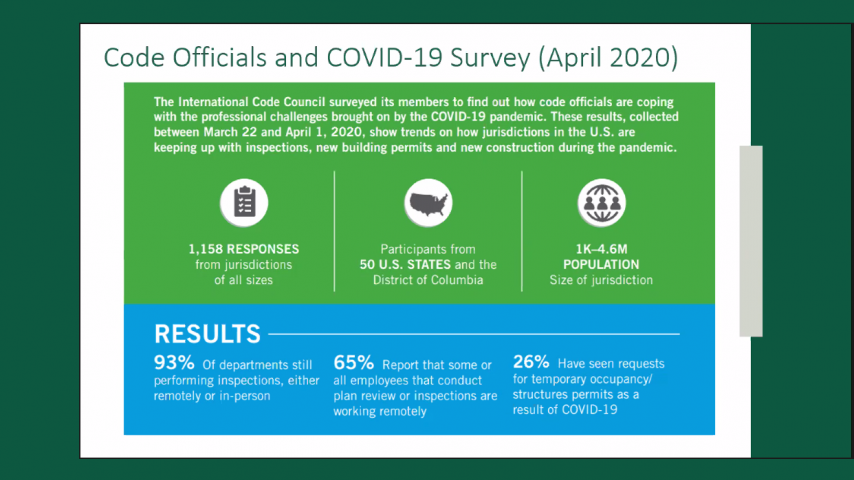
The COVID-19 crisis presented architecture, engineering and construction companies, and code departments with an enormous challenge: transitioning an industry long reliant on personal relationships and in-person connections to a remote, digital environment. Like other hands-on sectors, builders and other trades can’t ply their trades over Zoom.
The pandemic accelerated the need to bring building sites into the digital era through automated tools. Digital technology played a critical role in getting the $11 trillion construction industry back on its feet. The shift seen in the building industry not only shows its resilience, but it is one of the major positive changes to emerge from the crisis.
On July 13, 2021, the National Institute of Building Sciences hosted a panel of experts from the International Code Council and CloudVisit in the webinar, The Pandemic’s Impact on Technology in the Built Environment. Aundre Oldacre, Managing Partner with AoRa Development, served as moderator.
Subject matter experts discussed the safety and efficiency of virtual inspections, carbon footprint reductions, and access to building codes and standards in a digital environment. The webinar received more than 400 registrants.
THE BENEFITS TO VIRTUAL INSPECTIONS
While the concept of virtual inspections may not be new—particularly for industries other than construction—construction companies have begun using these inspections to monitor entire build-out projects, said Eric Ortner, Senior IT Project Manager with CloudVisit.
There are companies that provide remote video inspections specifically designed for the built environment. Remote inspection software can include advanced checklist functionality to ensure quality requirements are met and the seamless sharing of inspection evidence between construction managers, crew members, auditors and municipalities.
COVID-19 changed much of how business was conducted in 2020, with video conferencing coming to the forefront when face-to-face meetings were not an option.
“As a result of this, [it was] discovered that workers can work from home just as effectively as in the office,” Ortner said.
Ortner added that during the pandemic, the City of Tucson, Arizona’s Planning & Development Services went to 100 percent virtual inspections and continues to use them today. Observing other municipalities and their success with virtual inspections, New York City launched a pilot program for remote inspection in March 2021.
Health care institutions also are accepting remote inspections for facility maintenance, Ortner said.
There are many benefits for using remote inspections in the built environment, including reduced travel time to jobsites, the reduction of carbon emissions contributing to climate change, higher level of employee and quality assurance accuracy, and increased cost efficiency and labor savings.
CODE OFFICIALS AND COVID-19
Ryan Colker, J.D., CAE, Vice President of Innovation with the International Code Council, said ICC conducted a survey early in the pandemic to find out how code officials were coping with the professional challenges.
The results showed trends on how jurisdictions were keeping up with inspections, building permits, plan reviews, and construction, he said.
According to the survey, 93 percent of departments were still performing inspections either in-person or remotely. A total of 1,158 responses were collected from jurisdictions of all sizes. The survey was reconducted in September 2020 to see how departments had adapted. That survey found more departments were performing inspections (98 percent).
Working with the Northeast Energy Efficiency Partnership (NEEP) and the Midwest Energy Efficiency Alliance (MEEA), the Code Council conducted an additional survey on remote virtual inspections (RVI) in March 2021.
Jurisdictions reported performing all electronic plan reviews (34 percent), all paper (22 percent), or both (34 percent). The benefits to this is that it reduces paper/document management (65 percent) and streamlines review (50 percent).
Some of the barriers include integration with other software (35 percent) and learning new technology (34 percent).
By March 2021, jurisdictions reported in-person inspections were now 59 percent.
As governments look to implement remote processes as part of their essential public safety mission, funding under the American Rescue Plan is available.
DIGITAL ACCESS TO CODES
In addition to the need to shift to online processes, many code departments did not have access to code content, having relied on hard copy books housed in their office library. Additionally, hard copy code books also lack many tools that can be leveraged in a digital environment, including personal notations, linking code provisions in inspection reports, access to standards and other guidance referenced in the code, and being able to access code language in the field.
Digital Codes Premium provides easy access to the codes and tools to support their usability. To help jurisdictions use codes even more effectively, Colker said, ICC released a Digital Codes app into beta on July 12.
“It’s a mechanism for people to access codes from a smartphone or tablet,” Colker said. “[The app has] a lot of the functionality of our digital codes platform.”
COVID-19 forced the built environment to adapt to change. For example, travel time was cut down or halted, but the work needed to continue.
“COVID accelerated the uptick to more and more advanced technology,” Colker said.
THE NEXT RESILIENCE 2021 WEBINAR
The next Resilience 2021 webinar will cover wildland-urban interface fire resiliency. It is scheduled for August 11, 2021.
To register or view past webinar recordings and session papers, visit the Resilience 2021 Webinar Series.




